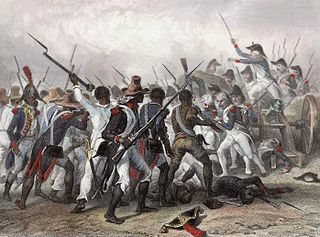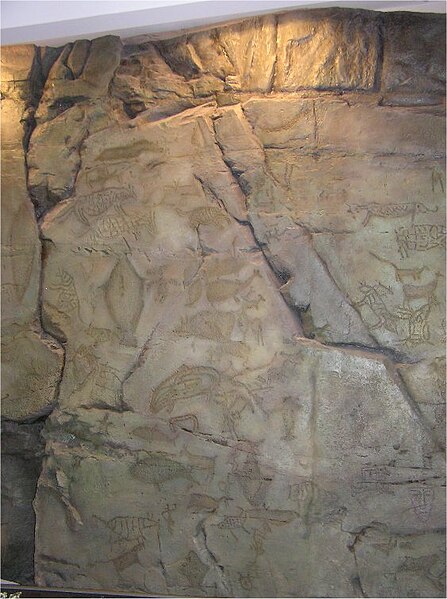 |
| Battle of Vertières (Haiti 1803) |
A very interesting study on Caribbean populations' autosomal ancestry is in the oven (pre-publication at arXiv).
Andrés Moreno Estrada et al., Reconstructing the Population Genetic History of the Caribbean. arXiv 2013 (pre-pub). Freely accessible → LINK [ref. arXiv:1306.0558v1]
Update (Nov 15): formally published at PLoS Genetics (open access → LINK). No apparent major changes.
Abstract
The Caribbean basin is home to some of the most complex interactions in recent history among previously diverged human populations. Here, by making use of genome-wide SNP array data, we characterize ancestral components of Caribbean populations on a sub-continental level and unveil fine-scale patterns of population structure distinguishing insular from mainland Caribbean populations as well as from other Hispanic/Latino groups. We provide genetic evidence for an inland South American origin of the Native American component in island populations and for extensive pre-Columbian gene flow across the Caribbean basin. The Caribbean-derived European component shows significant differentiation from parental Iberian populations, presumably as a result of founder effects during the colonization of the New World. Based on demographic models, we reconstruct the complex population history of the Caribbean since the onset of continental admixture. We find that insular populations are best modeled as mixtures absorbing two pulses of African migrants, coinciding with early and maximum activity stages of the transatlantic slave trade. These two pulses appear to have originated in different regions within West Africa, imprinting two distinguishable signatures in present day Afro-Caribbean genomes and shedding light on the genetic impact of the dynamics occurring during the slave trade in the Caribbean.
The most synthetic graph is the following one:
 |
| Figure 1: Population structure of Caribbean and neighboring populations. A) On the map, areas in red indicate countries of origin of newly genotyped admixed population samples and blue circles indicate new Venezuelan (underlined) and other previously published Native American samples. B) Principal Component Analysis and C) ADMIXTURE [12] clustering analysis using the high-density dataset containing approximately 390K autosomal SNP loci in common across admixed and reference panel populations. Unsupervised models assuming K= 3 and K=8 ancestral clusters are shown. At K=3, Caribbean admixed populations show extensive variation in continental ancestry proportions among and within groups. At K=8, sub-continental components show differential proportions in recently admixed individuals. A Latino-specific European component accounts for the majority of the European ancestry among Caribbean Latinos and is exclusively shared with Iberian populations within Europe. Notably, this component is different from the two main gradients of ancestry differentiating southern from northern Europeans. Native Venezuelan components are present in higher proportions in admixed Colombians, Hondurans, and native Mayans. |
As expected, Mexicans and most Colombians and Hondurans cluster mostly between Europeans and Native Americans, while Cuban, Dominicans and Haitians do between Europeans and Africans instead, with Puerto Ricans and some Colombians and Hondurans showing tripartite ancestry.
A most notable issue is that the bulk of Caribbean Latin American ancestry from Europe forms a distinctive component that the authors suggest is a founder effect from the early colonization almost 500 years ago but that I feel that deserves a closer look.
The authors provide also the full ADMIXTURE results for up to K=15, with cross-validation data, what is certainly appreciated by this blogger.
 |
Figure S3:
ADMIXTURE metrics at increasing K values
based on Log-likelihoods (A)
and cross-validation errors (B)
for results shown in Figure S2. |
Using table B, the best fit is K=7:
 |
| From Fig. S2 (ADMIXTURE results) |
Here we see a generic Mediterranean presence in Europe of the "black" component. Would it be just a simple reflection of European structure, then we should expect that the European component in Latin Americans would be c. 70% "red" and just 30% "black". But nope, not even in Cubans, who are the ones with the most recent European input overall (because it was a colony until a century ago).
This may indeed have the explanation that the authors suggest: that it is the result of a "recent" founder effect some 500 years ago in the early moments of the Castilian conquest and colonization of America. But still something does not ring correct. At the very least I have some doubts.
An alternative possibility that should be eventually tested could be that what we identify as "European" ancestry is in fact something European-like but not exactly European, for example North African and/or Jewish ancestry. There could be various sources for this trans-Mediterranean flow into America: on one side it has often been speculated (but never really proven) that a lot of Muslim and Jewish converts migrated to the colonies in the hope to escape the Inquisition. A major problem here is that most Muslim Iberians should be identical or nearly identical in ancestry other Iberians (Jews were not numerous enough probably anyhow).
But another interesting possibility is that many North Africans (including Canarian Aborigines or Guanches) may have been enslaved early on to supply the plantations of the Caribbean. Initially the excuse for slavery was not "racial" (an Illustration development in fact) but "religious". There are known many Papal edicts insisting that Canarian converts would not be enslaved, something that the Portuguese (first colonial power in the archipelago) did anyhow again and again. It is plausible (but ill-documented) that North African conquest campaigns and raids by Portugal first and Castile later would also capture many slaves in those areas, slaves that would probably end up in America in many cases, where they may have been emancipated eventually, becoming part of the Mestizo backbone of the Castilian colonial empire.
I know I am speculating a bit here but it is an interesting alternative to explore. In this regard I really miss North African control populations, because they would shed light on this intriguing matter.
Another issue the paper explores is the origin of African ancestry, finding that the oldest ancestry is mostly from westernmost Africa (Mandenka, Brong as reference populations), while more recent ancestry is mostly from the Nigeria-Angola arc (Yoruba, Igbo, Bamoun, Fang and Kongo).
The study also tries to reconstruct population history but some of their results are perplexing and highly unlikely.
 |
| Figure 3: Demographic reconstruction since the onset of admixture in the Caribbean. We used the length distribution of ancestry tracts within each population from A) insular and B) [not shown] mainland Caribbean countries of origin. Scatter data points represent the observed distribution of ancestry tracts, and solid-colored lines represent the distribution from the model, with shaded areas indicating 68.3% confidence intervals. We used Markov models implemented in Tracts to test different demographic models for best fitting the observed data. Insular populations are best modeled when allowing for a second pulse of African ancestry, and mainland populations when a second pulse of European ancestry is allowed. Admixture time estimates (in number of generations ago), migration events, volume of migrants, and ancestry proportions over time are given for each population under the best-fitting model. The estimated age for the onset of admixture among insular populations is consistently older (i.e., 16-17) compared to that among mainland populations (i.e., 14). |
The really perplexing issue here is that in Haiti and Cuba particularly, the latest and quite notable arrival of African ancestors corresponds to a mere four generations ago, what means (as the approx. generation length is of c. 30 years, not longer because then the earliest European arrival would be before Columbus' feat) a mere 120 years ago, i.e. around 1890.
The reality is that Haiti became independent
in 1791-1804 and no relevant demographic inflow has happened since then. Similarly the last major batch of slaves to
Cuba (from Spain, where slavery was being outlawed, as well as from Haiti itself) was in the earliest 19th century (however slavery would not be abolished in Cuba until 1884, although human trade was declared illegal in 1835 under British pressure).
Therefore there must be an error of some sort in these reconstructions, which generate more recent African inflows that are realistically possible.
Update (3 Nov): Canary Islands were a major source of Caribbean "white" ancestry.
A very interesting and informative discussion with a Puerto Rican in search of his ancestry arose recently
at my old blog Leherensuge. Charles provided very useful information on this matter and told me about aspects of the history of the colonization of America, and very especially the strategical (but economically less important) islands of the Greater Antilles.
A very unknown historical element is that Castile (not as much as Portugal but still) lacked great amounts of willing settlers in its free (non-serf) population and that therefore it had to look for assimilated colonists in odd places like the Canary Islands, where the clannish Guanches (the distinctive aboriginal islander Berbers) seem to have served that purpose by grade or force.
For example, in 1678 the Castilian Government issued a decree (
cédula) that has become popularly known as
Tributo de Sangre[es] (
Blood Tribute) by which the Canarian oligarchs were imposed a "tax" of nine families to be moved to the Caribbean for each 1000 tons of local exports to America. There are some historians who
criticize[es] this concept as "a myth" but what seems very clear is that, either way, Canarian Aborigines contributed heavily to the settlement of "Spanish America", very especially the Dominican Republic, Puerto Rico and Cuba.
So it seems I was correct in imagining a North African origin of this "black" component of Caribbean European-like ancestry. Of course, it still awaits a formal test of comparison with North Africans but I am pretty much persuaded now.
This is an interesting example of settlement with a culture (Castilian/Spanish in this case) different from the genetic roots of the population (largely Aboriginal Canarian). A similar example can well be that of the Irish (partly forced) settlement of Australia, carrying an "English" language and identity but effectively being from a different origin. In the case of Quebec it is also very probable that most original settlers came from some specific region of the French state and surely not from the "core France" around Paris (Southwest? - still untested but there is a very clear founder effect in any case).
I wonder how many other such cases have happened also in prehistory. For example: how genuinely "Indoeuropean" (by blood) were the Celts or other invaders of the Metal Ages. The likely answer is: probably not much. This has probably happened a lot but is in most cases undocumented. Only careful and dispassionate genetic research can give us some answers.
Update (Feb 16 2014): Charles has found another very interesting study, with plenty of data, which illustrates the continuous flow of Canarians to the Spanish possessions in the Caribbean. It is in Spanish language however:
Juan Manuel Santana Pérez, Isleños en Cuba y Puerto Rico (del siglo XVIII a mediados del XIX). Cuadernos Americanos nº 126, 2008 → LINK (freely accessible PDF).
Update (Oct 12 2018): Independent research just published
HERE shows that about half of the ancestry of Puerto Ricans is Berber (North African) rather than Iberian and thus that the Guanche or Canario ancestry hypothesis posited by Charles is almost certainly correct.




















